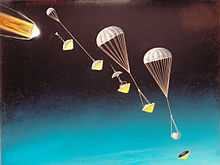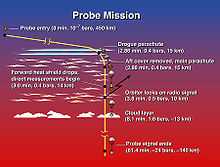Galileo Probe

The Galileo Probe was an atmospheric-entry probe carried by the main Galileo spacecraft to Jupiter, where it directly entered and returned data from the planet.[1] The 339-kilogram (747 lb) probe was built by Hughes Aircraft Company[2] at its El Segundo, California plant, measured about 1.3 meters (4.3 ft) across. Inside the probe's heat shield, the scientific instruments were protected from extreme heat and pressure during its high-speed journey into the Jovian atmosphere, travelling at 47.8 kilometers (29.7 mi) per second.
The probe was released from the main spacecraft in July 1995, five months before reaching Jupiter, and entered Jupiter's atmosphere with no braking beforehand. The probe was slowed from its arrival speed of about 47 kilometers per second to subsonic speed in less than two minutes.
At the time, this was by far the most difficult atmospheric entry ever attempted; the probe had to withstand 230 g[3] and the probe's 152 kg heat shield, making up almost half of the probe's total mass, lost 80 kg during the entry.[4][5] NASA built a special laboratory, the Giant Planet Facility, to simulate the heat load, which was similar to the convective heating experienced by an ICBM warhead reentering the atmosphere combined with the radiative heating of a thermonuclear fireball.[6][7] It then deployed its 2.5 meters (8.2 feet) parachute, and dropped its heat shield, which fell into Jupiter's interior.
As the probe descended through 156 kilometres (97 mi)[1] of the top layers of the Jovian atmosphere, it collected 58 minutes of data on the local weather. It only stopped transmitting when the ambient pressure exceeded 23 atmospheres and the temperature reached 153 °C (307 °F).[8] The data was sent to the spacecraft overhead, then transmitted back to Earth. Each of 2 L-band transmitters operated at 128 bits per second and sent nearly identical streams of scientific data to the orbiter. All the probe's electronics were powered by lithium sulfur dioxide (LiSO2) batteries that provided a nominal power output of about 580 watts with an estimated capacity of about 21 ampere-hours on arrival at Jupiter. The probe included six instruments for taking data on its plunge into Jupiter:
- an atmospheric structure instrument group measuring temperature, pressure and deceleration,
- a neutral mass spectrometer,
- a helium-abundance interferometer supporting atmospheric composition studies,
- a nephelometer for cloud location and cloud-particle observations,
- a net-flux radiometer measuring the difference between upward and downward radiant flux at each altitude, and
- a lightning/radio-emission instrument with an energetic-particle detector that measured light and radio emissions associated with lightning and energetic particles in Jupiter's radiation belts.
In addition, the probe's heat shield contained instrumentation to measure ablation during descent.[9] Total data returned from the probe was about 3.5 megabits (~460,000 bytes). The probe stopped transmitting before the line of sight link with the orbiter was cut. The likely proximal cause of the final probe failure was overheating, which sensors indicated before signal loss.
The atmosphere through which the probe descended was somewhat hotter and more turbulent than expected. The probe was eventually completely destroyed as it continued to descend through the molecular hydrogen layer beneath the Jovian cloud tops. The parachute would have melted first, roughly 30 minutes after entry,[10] then the aluminum components after another 40 minutes of free fall through a sea of supercritical fluid hydrogen. The titanium structure would have lasted around 6.5 hours more before disintegrating. Due to the high pressure, the droplets of metals from the probe would finally have vaporized once their critical temperature had been reached, and mixed with Jupiter's liquid metallic hydrogen interior.
Jupiter was found to have half the amount of helium expected.[1] Also, the data did not support the three-cloud layer theory.[1] It detected less lightning, less water, but more winds than expected; consistent 530 kilometers per hour (330 mph) winds during its descent.[1] No solid surface was detected during its journey downward to 156 kilometres (97 mi).[1]
Images
 Artist's impression of the probe's entry into Jupiter's atmosphere |
 The descent module |
 Timeline of the probe's atmospheric entry. |
References
- ↑ 1.0 1.1 1.2 1.3 1.4 1.5 Galileo Probe Science Results
- ↑ "Hughes Science/Scope Press Release and Advertisement, retrieved from Flight Global Archives May 23, 2010". flightglobal.com. Retrieved 2011-05-15.
- ↑ Chu-Thielbar (2007-07-19). "Probing Planets: Can You Get There From Here?". Retrieved 2007-07-27.
- ↑ Julio Magalhães (1997-09-17). "Galileo Probe Heat Shield Ablation". NASA Ames Research Center. Retrieved 2006-12-12.
- ↑ Julio Magalhães (1996-12-06). "The Galileo Probe Spacecraft". NASA Ames Research Center. Retrieved 2006-12-12.
- ↑ Laub, B.; Venkatapathy, E. (6–9 October 2003). "Thermal Protection System Technology and Facility Needs for Demanding Future Planetary Missions" (PDF). International Workshop on Planetary Probe Atmospheric Entry and Descent Trajectory Analysis and Science. Lisbon, Portugal. Retrieved 2006-12-12.
- ↑ Bernard Laub (2004-10-19). "Development of New Ablative Thermal Protection Systems (TPS)". NASA Ames Research Center. Retrieved 2006-12-12.
- ↑ "''Galileo'' Mission to Jupiter, NASA". .jpl.nasa.gov. Retrieved 2011-05-15.
- ↑ Milos, Frank S. (1997). "Galileo Probe Heat Shield Ablation Experiment". Journal of Spacecraft and Rockets 34 (6): 705–713. doi:10.2514/2.3293.
- ↑ Jonathan McDowell (1995-12-08). "Jonathan's Space Report, No. 267". Harvard-Smithsonian Center for Astrophysics. Retrieved 2007-05-06.